This is the beginning of our journey with Ethereum 2.0 beacon chain. Below
is a list of frequently used terms that would be helpful for new users, developers to start a journey with Ethereum's Proof of Stake (PoS) protocol.
Happy staking !!
Beacon chain
Beacon chain - The beacon chain is the system chain for Ethereum 2.0. The main responsibilities of the beacon chain are to store and maintain the registry of validators, process crosslinks, process its per-block consensus, as well as the finality gadget. It is the central PoS chain that is the base of the sharding system.
Shard chain - One of the chains on which user transactions take place and account data is stored.
Slot - A period during which one proposer has the ability to create a beacon chain block and some attesters have the ability to make attestations.
Epoch - An aligned span of slots during which all validators get exactly one chance to make an attestation.
Block root - A 32-byte Merkle root of a beacon chain block or shard chain block. Previously called "block hash".
Genesis time - the Unix time of the genesis beacon chain block at slot 0.
Crosslink - a set of signatures from a committee attesting to a block in a shard chain that can be included into the beacon chain. Crosslinks are the main means by which the beacon chain "learns about" the updated state of shard chains.
Validator
A validator is a registered participant in the Beacon chain. It is very much like the node or the miner of 'Proof of Work' protocol except they are engaged in the process with Ethereum 2.0 chain (Beacon chain) only when they make a security deposit by sending ether (ETH) into the Ethereum 1.0 deposit contract. Validation in Eth2 can not be done without a security deposit.
Active validator - An active participant in the Ethereum 2.0 consensus invited to, propose and attest to blocks and vote for crosslinks, among other things.
Proposer - The validator that creates a beacon chain block.
Attester - A validator that is part of a committee that needs to sign off on a beacon chain block while simultaneously creating a link (crosslink) to a recent shard block on a particular shard chain.
Committee - A randomly sampled subset of active validators, chosen to perform duties for a given slot on a selected shard is known as Committee.
Staking
Staking - An act of depositing ETH on Eth1 chian in order to act as a validator on Ethereum’s proof-of-stake Beacon Chain and be eligible to earn staking rewards.
Issuance Rate- The annualized rate at which ETH supply grows.
Return Rate - The annualized rate at which validators are rewarded (in ETH).
Withdrawal period - the number of slots between a validator exit and the validator balance being withdrawable. If there is no withdrawal queue, then the minimum withdrawal time is 18 hours. This is adjusted dynamically depending on how many people are withdrawing at that time.
Note: This page is continuiously updated based on the latest development in Ethereum 2.0 chain. If any term is missing, that you'd like to be added in the present list, or have any related query, please email to contact@etherworld.co with description.
Follow EtherWorld's Good Read on Blockchain & Cryptocurrency to understand other concepts & useful terms frequently used in the blockchain technology.
Resources
________________________________________________________Disclaimer: The information contained on this web page does NOT constitute financial advice or a solicitation to buy or sell any cryptocurrency contract or securities of any type. Trading is a high-risk activity. Readers are suggested to conduct their own research, review, analyze and verify the content before relying on them.
To publish press releases, project updates and guest posts with us, please email at contact@etherworld.co.
You've something to share with the blockchain community, join us on Discord!
Follow us on Twitter, Facebook, LinkedIn, Medium and Instagram.








